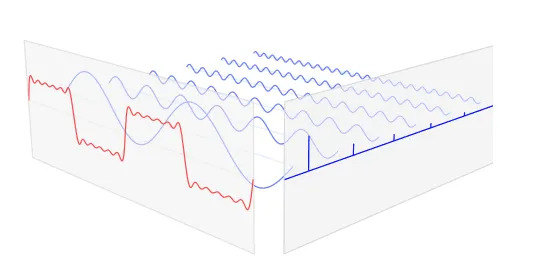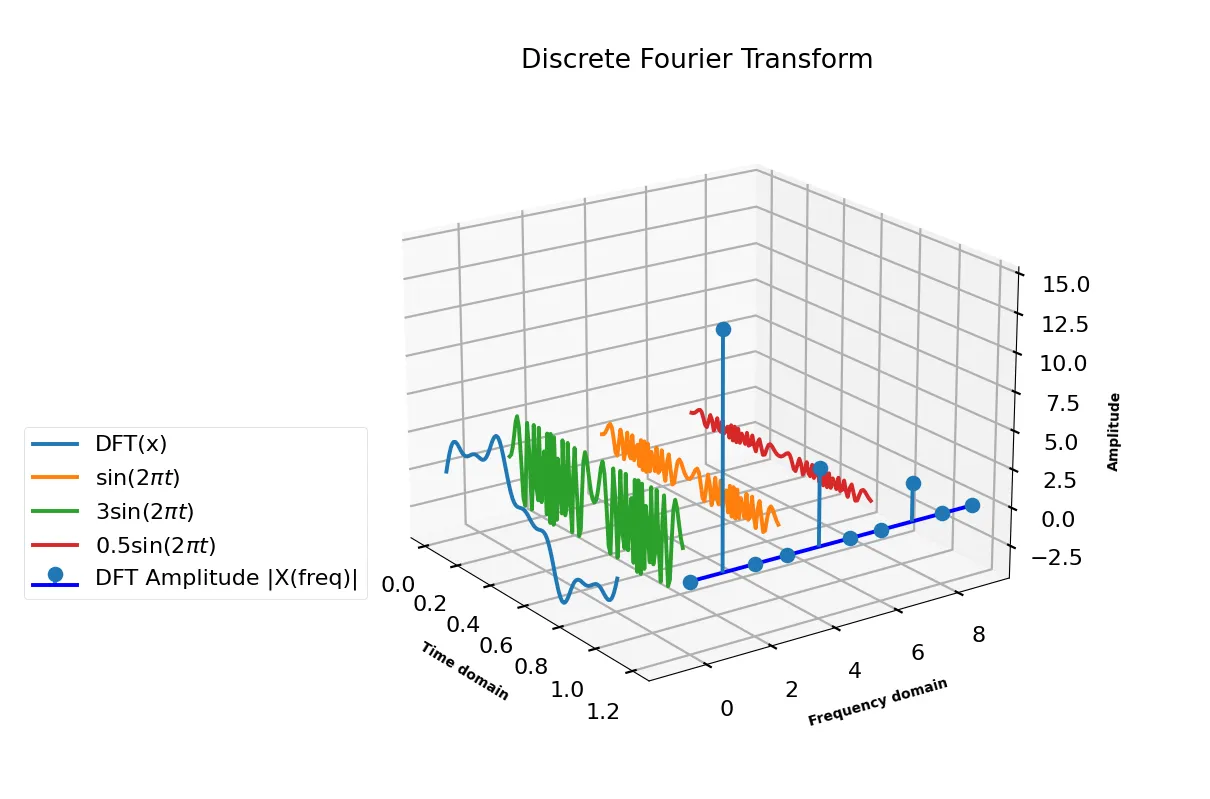我通过使用Tikz看到了这个:
https://tikz.net/fourier_series/
我想创建这个傅里叶级数的3D合成:
 使用Python 3D绘图,有一个能够实现这个的matplotlib。
使用Python 3D绘图,有一个能够实现这个的matplotlib。
我的MWE / 我已经实现的是:
 使用Python 3D绘图,有一个能够实现这个的matplotlib。
使用Python 3D绘图,有一个能够实现这个的matplotlib。我的MWE / 我已经实现的是:
# https://pythonnumericalmethods.berkeley.edu/notebooks/chapter24.02-Discrete-Fourier-Transform.html
# Generate 3 sine waves with frequencies 1 Hz, 4 Hz, and 7 Hz,
# amplitudes 3, 1 and 0.5, and phase all zeros.
# Add this 3 sine waves together with a sampling rate 100 Hz
import matplotlib.pyplot as plt
import numpy as np
plt.style.use('seaborn-poster')
# sampling rate
sr = 100
# sampling interval
ts = 1.0/sr
t = np.arange(0,1,ts)
freq = 1.
x = 3*np.sin(2*np.pi*freq*t)
x1 = 3*np.sin(2*np.pi*freq*t)
freq = 4
x += np.sin(2*np.pi*freq*t)
x2 = np.sin(2*np.pi*freq*t)
freq = 7
x += 0.5* np.sin(2*np.pi*freq*t)
x3 = 0.5* np.sin(2*np.pi*freq*t)
# Write a function DFT(x) which takes in one argument,
# x - input 1 dimensional real-valued signal.
# The function will calculate the DFT of the signal and return the DFT values.
def DFT(x):
"""
Function to calculate the
discrete Fourier Transform
of a 1D real-valued signal x
"""
N = len(x)
n = np.arange(N)
k = n.reshape((N, 1))
e = np.exp(-2j * np.pi * k * n / N)
X = np.dot(e, x)
return X
X = DFT(x)
# calculate the frequency
N = len(X)
n = np.arange(N)
T = N/sr
freq = n/T
n_oneside = N//2
# get the one side frequency
f_oneside = freq[:n_oneside]
# normalize the amplitude
X_oneside =X[:n_oneside]/n_oneside
# subplot(2, 2, 3)), the axes will go to the third section of the 2x2 matrix
# i.e, to the bottom-left corner.
plt.figure(figsize = (12, 6))
plt.subplot(3, 1, 1)
plt.plot(t, x, 'r')
plt.ylabel('Amplitude')
plt.subplot(3, 1, 2)
plt.stem(f_oneside, abs(X_oneside), 'b', \
markerfmt=" ", basefmt="-b")
plt.xlabel('Freq (Hz)')
plt.ylabel('DFT Amplitude |X(freq)|')
plt.xlim(0, 10)
plt.subplot(3, 2, 5)
plt.plot(t, x1, 'g')
plt.ylabel('Amplitude')
plt.subplot(3, 2, 6)
plt.plot(t, x2, 'g')
plt.ylabel('Amplitude')
plt.tight_layout()
plt.show()
- 单一正弦波
- 傅里叶级数(由第一项开始的所有正弦波的总和)
- DFT图

